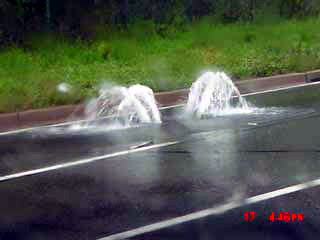How much does your DNA determine your future? Our reporter has her DNA analyzed by three different labs, and shares every detail of the results... as well as how she copes with them.
read more | digg story
read more | digg story
Autodesk Technologist with Information about Stormwater Management Model (SWMM) for watershed water quality, hydrology and hydraulics modelers (Note this blog is not associated with the EPA). You will find Blog Posts on the Subjects of SWMM5, ICM SWMM, ICM InfoWorks, InfoSWMM and InfoSewer.
What is Puddleblog, you ask? Puddleblog chronicles the epic journey of one puddle, bracing for an uncertain future.
It’s a blog. You know, for a puddle. Specifically, the puddle that graces the corner of Jay and Plymouth, a couple blocks east of the Manhattan Bridge. Maybe if this thing catches on we can think about including other qualified puddles.

The Joys Of Non-Driving
22 Jun 2008 09:33 pm
It proves I'm not an American, I guess, but I still don't know how to drive, don't have a license and have managed to get to the age of 44 without missing one. Yes, the husband has to drive us all the way to Ptown each summer, but once I get here, even more than when I'm in DC, this sentiment by C.S. Lewis rings all the more true:
I number it among my blessings that my father had no car, while yet most of my friends had, and sometimes took me for a drive. This meant that all these distant objects could be visited just enough to clothe them with memories and not impossible desires, while yet they remained ordinarily as inaccessible as the Moon. The deadly power of rushing about wherever I pleased had not been given me. I measured distance by the standard of man, man walking on his two feet, not by the standard of the internal combustion engine. I had not been allowed to deflower the very idea of distance; in return I possessed "infinite riches" in what would have been to motorists "a little room."
The truest and most horrible claim made for modern transport is that it "annihilates space." It does. It annihilates one of the most glorious gifts we have been given. It is a vile inflation which lowers the value of distance, so that a modern boy travels a hundred miles with less sense of liberation and pilgrimage and adventure than his grandfather got from traveling ten. Of course if a man hates space and wants it to be annihilated, that is another matter. Why not creep into his coffin at once? There is little enough space there.
$4 gas? Maybe it will be good for us.
Permalink :: Trackback (0) :: Sphere It!
These are the Delphi 7 options that should be used to prevent the integer overflow problem from occurring when using the Zoom command. Overflow checking and any Debugging options seem to be the cause of the integer overflow problem.
Below is an example prompt you can use (in ChatGPT or any advanced language model that understands SWMM5 syntax) to generate a syntactical...
This version is a QA/QC version of SWMM 5 that was used to more closely compare the SWMM 4 to SWMM 5 results using extra data variables.
It should not be used for modeling. You should use the EPA SWMM Web site to download the latest EPA SWMM version:
http://www.epa.gov/ednnrmrl/models/swmm/index.htm